Planning for Alignment and Engagement
| Site: | Technology-Enabled Learning Lounge |
| Course: | Developing & Teaching Online Courses |
| Book: | Planning for Alignment and Engagement |
| Printed by: | Guest user |
| Date: | Monday, 15 December 2025, 2:06 PM |
Description
This book guides you through the creation of a course plan using this template. Please save the template to your own computer as you will be asked to update it with new information as you go through this section of the course.
Effective Learning Objectives
Establishing learning objectives for your course is one of the most important and significant steps in the planning process. In the last section you explored the importance of aligning course goals with learning objectives. So now, it is time to make sure that you have effective learning objectives to guide your decisions about what content needs to be taught and to keep you focused on what the learners will be able to do at the end of the instruction.
In higher education, best practices endorse Bloom's taxonomy as a classification method to guide the writing of learning objectives and you will explore what that means through a group webquest.
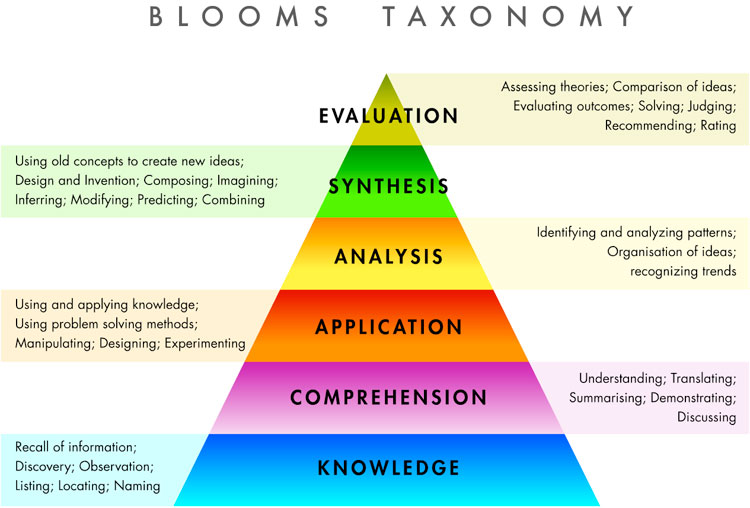
As you work through your discovery activity you will learn that the taxonomy has been updated in the not so distant past, showing a reversal of the top two categories:
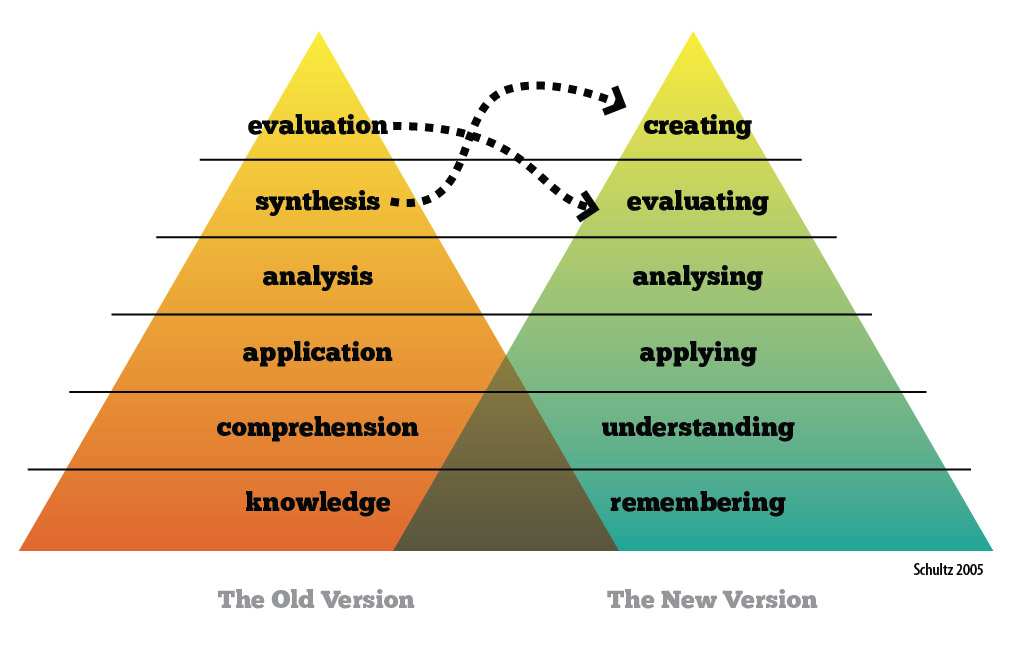
This is a good reminder that in learning design, nothing is ever 'written in stone' and the design process is iterative as it changes as you learn more about the content, your learners and the context and environment around you.
Getting Started with the Planning
In the previous modules you did quite a bit of high level thinking about planning your course. After establishing the overall course intent you saw how it provided a framework for determining learning outcomes. It became clear how the course intent and the learning outcomes aligned to provide a road map for what your expectations are for student learning. Now, it is time to roll up your sleeves and get going with the process.
Learning Outcomes vs. Learning Objectives
Before we go on, let's reflect a bit on the terminology. As you explore the literature on the topic of learning outcomes, you may see them also referred to as learning objectives. In fact, it is common to see the two terms used interchangeably. Without wanting to get too hung-up on definitions, in this course we will use the term 'learning objectives' as
statements of student learning that identify the desired learning outcome by describing what learners will realistically be able to do upon completion of a learning experience.
Learning Objectives and Planning
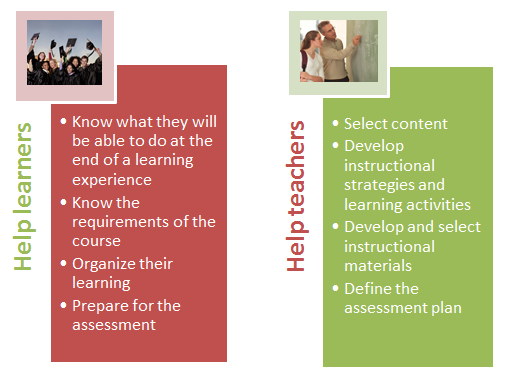
Determining learning objectives after determining the course intent is the first step in planning your course. The learning objectives not only help you with planning your course, they also help learners as they work through the course.
Therefore, it is worth spending some time crafting effective learning objectives from the outset. Educators worldwide use Bloom's Taxonomy as a frame of reference for developing effective learning objectives.
Bloom's Taxonomy
Benjamin Bloom was an American educational psychologist who organised learning objectives into a taxonomy of learning classified into three main domains, further classified into specific categories:
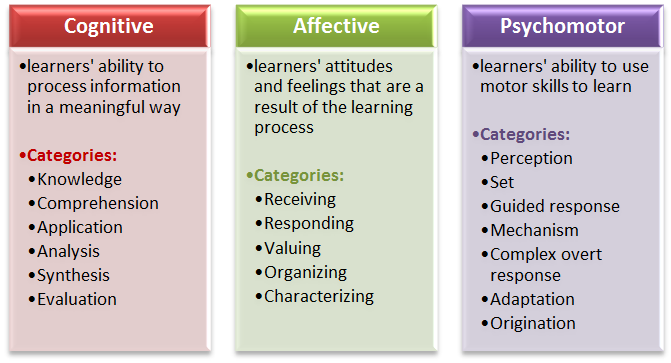
This framework informs and guides the writing of learning objectives and learning assessment.

Webquest Activity
As part of this small webquest activity you will be working in your groups to:
- write learning objectives for your course according to Bloom's Taxonomy
- recommend teaching approaches that can be used to attain each learning objective
- explain how the taxonomy guides assessment of learning
To get started, distribute the links below across the members of your group so that each member has at least a couple of sites to visit:
- Wikipedia's Bloom's Taxonomy
- Bloom's Taxonomy of Learning Domains
- Teaching / Learning Bloom's Taxonomy
- Bloom's Taxonomy Overview
- Bloom's Taxonomy and Assessment
- Revised Bloom's Taxonomy
- A Model of Learning Objectives
- About Learning Objectives
- Writing Learning Objectives
- Guide to Writing Learning Outcomes
Each group makes notes about the key aspects of the taxonomy and how it guides the writing of effective learning objectives and the subsequent assessment strategy. You may use the LO Webquest Discussion to discuss your notes and reach agreement.
Each group writes one learning objective that can be used in one of the courses, puts forward two ideas for assessment of that objective and recommends at least two instructional strategies or teaching approaches that can be used to help students meet that objective.
Each group will post the learning objective, the ideas for assessment and the teaching approaches to the LO Webquest Discussion forum.
Writing Effective Learning Objectives
As you learned in the webquest activity, to be effective, learning objectives need to be:

To write learning objectives that are specific, observable and measurable statements, it helps to include the following components, which we call the "PCCs of learning objectives":

Performance: is a description of what learners will be able to do at the end of the learning experience. It is designated by an action verb so that it is observable.
Conditions: define the conditions in which learners will perform the learning tasks. This is what makes your learning objective specific.
Criteria: define how learners will be assessed. This component of your learning objective is what makes it measurable.
Let's have a look at an example of an effective learning objective that includes the PCCs:

Examples

And now, let's compare a couple of examples of learning objectives, based on their effectiveness:

Examples
| Non-effective | Effective |
|
|
|
|

Activity
- If you haven't done so, download the course plan document and save it to your hard drive.
- In the learning objectives column, write the learning objectives for your course.
- Make sure the learning objectives are written according to Bloom's Taxonomy and include the Performance, Conditions and Criteria!
Learner Engagement
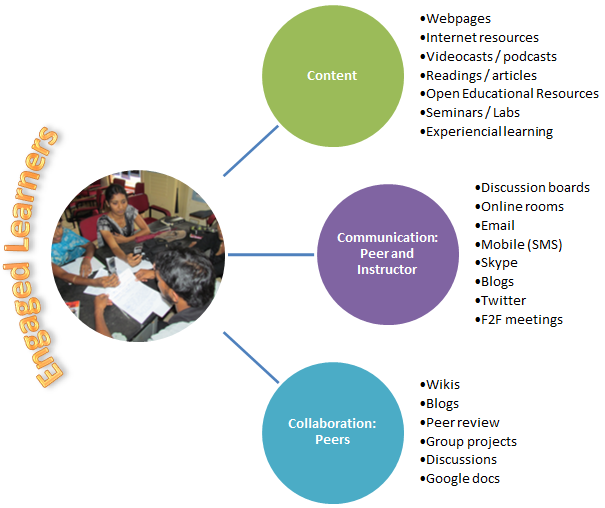 Learner engagement is fundamental for meaningful learning experiences. A big component of the planning process is the thinking around learning activities: thinking about which activities will be relevant and contextual for the learners and designing the interaction so that it is easy to follow and supports the learning process.
Learner engagement is fundamental for meaningful learning experiences. A big component of the planning process is the thinking around learning activities: thinking about which activities will be relevant and contextual for the learners and designing the interaction so that it is easy to follow and supports the learning process.
Designing technology-based learning activities can result in "cool" student interactions; however, it is important not to lose sight of the fact that technology should enhance the learning experience, not drive it.
Why Learning Activities?
Learning activities provide opportunities for learners to interact with the material being learnt, practice concepts learned and apply them to new situations. Presenting activities as part of the learning materials engages learners to think about what they are learning, which promotes a richer and deeper learning experience.
Importance of Learner Engagement
Think about your experience as a teacher or as an instructor. What happens when you spend all your time talking to your students, transmitting information? Chances are you start to notice that they get distracted... they may start checking their mobile phones, or checking their watches. In the case of online courses, if your course is only composed of blocks of descriptive text, chances are your student will get tired of reading and leave the course altogether. Well, this happens because they are not engaged in the learning process.
How to Engage Learners
So how do we engage learners? Well, we do that by making them active participants in the learning process. And we achieve this by planning contextual and meaningful learning activities for students to do throughout the course. These activities can have a variety of aims:
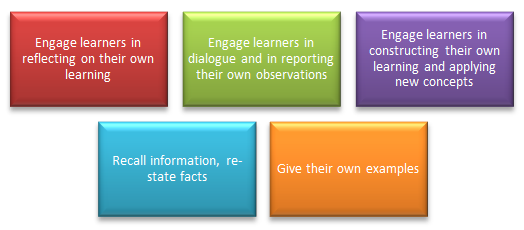
Depending on what you want to attain with a specific learning activity for your course, you will decide on what type of activity you want to engage your learners in. And don't forget... the learning activity must be aligned with the learning objectives.

Example
Say for example that I am teaching an online course on Auto Mechanics. One of the topics I cover is Brake Systems. My learning objective states that by the end of my lesson on Brake Systems, learners will be able to:
- List the two characteristics of hydraulic brakes in sedan models.
The aim of my activity is to have students recall information and re-state facts. Therefore, I choose to create a multiple choice question with five answer choices, with characteristics of both hydraulic and line brake systems. I design the answer choices to include two characteristics of hydraulic brakes and to accept multiple selection of answer choices. I set the correct choices to the two characteristics of hydraulic brake systems.
If the learning outcome had been to:
- discuss the characteristics of hydraulic and line brake systems.
the aim for the activity would be to engage learners in dialogue, therefore I would create a discussion forum where students could discuss the characteristics of brake systems.
So, as you see, by aligning the learning activities with the learning objectives and considering what the aim for the activity is, I can easily get ideas for what type of activity I should design to engage my learners and create a deeper, more meaningful learning experience. As you go through the process of planning learning activities, keep in mind that this is an iterative stage: as you come up with learning activities, you may have to revise the learning objectives and vice-versa. As this stage nothing is written in stone, and the process allows you to narrow down exactly what needs to be taught and how.

Activity
- In the course plan document (learning activities column), briefly describe what learning activities you are planning to help learners attain the learning objectives.
Different Types of Learning Activities
There are many kinds of learning activities that you can plan for your online or blended course. From individual activities to group activities, from synchronous activities to asynchronous activities... your creativity is the limit. You can design online discussions, plan collaborative activities for discovery learning where students have to search the web and other resources to learn specific concepts to share with their peers, phased assignments where students submit pieces of work that build on each other, matching activities, ordering and listing activities, among others.
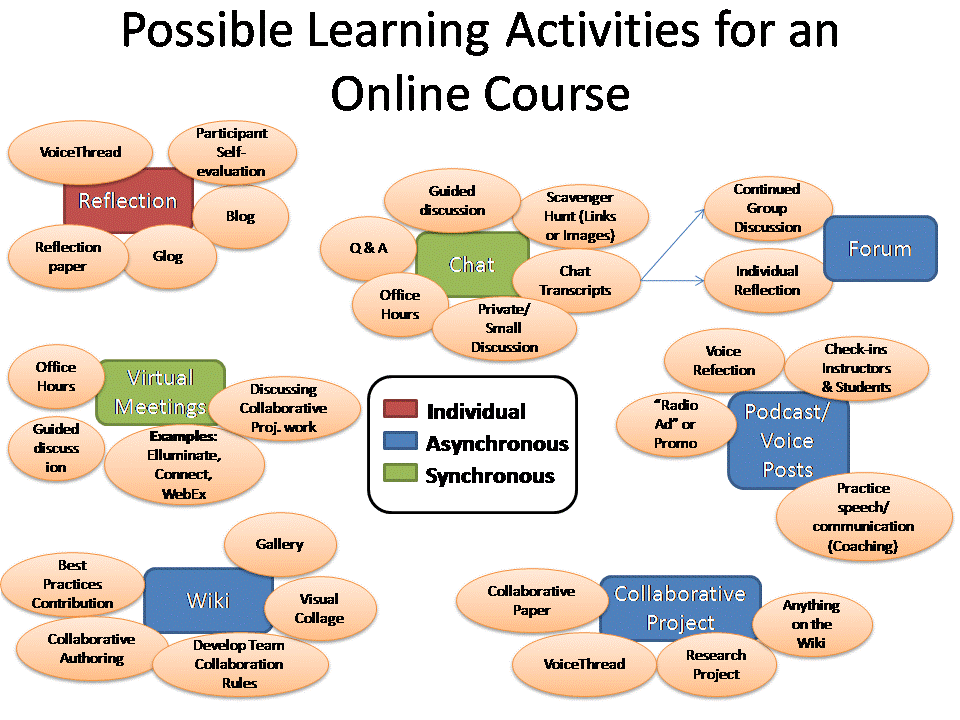 |
| CC by SA 2.5 (http://nkilkenny.wordpress.com/category/analysis/) |
In blended courses, you can take advantage of the face-to-face sessions to engage your students in group work, debates, practice labs, role playing activities and many others.
Good and effective learning activities are relevant for the student learning and provide meaningful feedback aimed at guiding students through the learning process.

Examples
This site provides a few examples of self-guided and collaborative activities that can be integrated in online and blended courses.
Activities and Feedback
Every learning activity should include feedback to guide learners in their learning journey. Without feedback, it is difficult for learners to know if they are on the right track. Therefore it is important to include feedback on both correct and incorrect answers, and create opportunities to remediate learning upon completion of the activity, if necessary.

Reading Activity
This excerpt from "Creating Learning Materials for Open and Distance Learning" offers a good overview of learning activities with examples and a suggested activity format framework.
Characteristics of Effective Feedback
Feedback is most effective when provided immediately after the activity is completed, be it a quiz or a submitted assignment. Of course, an online quiz can be graded by the computer and, therefore, learner feedback can be provided immediately. However, if learners submit an assignment, it will take time for the instructor to grade it and provide appropriate feedback. It is important though to provide learners with feedback within as short a timeframe as possible (2-5 days constitutes acceptable practice).
The most effective feedback is comprehensive and explained to the learners. Telling your learners that their answer is "Correct" or "Incorrect" is somewhat helpful; however, telling them why it is "correct" reinforces learning and telling them why it is "incorrect" guides them in the right direction.

Examples
Have a look at this example of a simple online quiz. Notice how the feedback is provided with each answer. Try to answer some questions correctly and others incorrectly to see how the feedback is provided.
And this is a sample of feedback provided to an assignment that was submitted for grading. Notice the level of detail in the feedback provided - telling your students "Good job!" or "Needs improvement" doesn't help them much, so keep that in mind when grading any student work.
A few important considerations when planning learning activities:
- Learning activities should be meaningful and relevant for students and the subject matter being taught.
- Learning activities must be aligned with the learning outcomes
- Each learning activity should incorporate feedback to guide learners
- Each learning activity should be structured to include:
- Motivational introductions
- Clear instructions for the task to complete
- Answer grid
- Time guide (how long should students take to complete it)
- Feedback and comments

Discussion
Take some time now to participate in the Learning Activities discussion, where you will share the course plan you have created so far.
Using Web-based Tools to Facilitate Engagement
The rapid growth and development of the Internet has opened up the possibilities for online teaching and learning to incorporate non-static web-based tools (also referred to as Web 2.0 tools) to engage learners at different levels: from interaction to collaboration to co-creation of content. Web 2.0 tools allow for transformational experiences in teaching and learning, as learners become active creators of content as part of their learning engagement.
Using tools such as blogs and discussion forums in teaching and learning engage learners to reflect on the learning experience and think critically as they share their observations and experiences. The use of YouTube and wikis encourage learners to construct their own meaning and collaborate to create content. The advent of social media tools, such as Facebook and Twitter, has expanded the reach of learning networks and has made learning a global affair. It is common practice now to design engaging activities that encourage learners to publish their own content: a video on YouTube, a tweet about something, a group on a social network space, a group project using a wiki, a reflective entry on a weblog.

Examples
This testimonial illustrates how Web tools, in this case blogs, can enhance teaching and learning through different levels of engagement between teachers and learners.
Assessment of Learning
By continuously assessing the learning experience, instructors gain insight as to whether learners are in fact learning. Therefore, having a mix of formative and summative assessment is fundamental to enable instructors the opportunity to remediate learning and guide learners to be successful.
In this section you will go over the different types of assessment strategies that you can employ in online and blended learning environments and you will discuss the importance of self-assessment for adult learners.
Assessing Learning
In the previous section you developed an assessment strategy for the entire course. That is part of what is typically referred to as summative assessment for the course. At certain intervals during the course, students are assessed to see if they are learning what they are supposed to learn, which has been determined by the course learning objectives. Summative assessment is typically associated with a grade which represents the standard to which learners have performed.
In this section, we are going to focus on formative assessment, which has particular importance in online and blended learning. Formative assessment aims to motivate learners by providing an indication of their progress. It gives them an idea of where they are in the process, and offers guidance on what to do next and how to proceed. Should students review a concept to make sure they are successful or are they apt to continue on to the next stage? As you can guess, this type of guidance is especially important when learners are studying on their own or at a distance. Formative assessment tends to be continuous, which means that learners are assessed throughout the learning process and not just at specific intervals in a course or at the end of the course. Adult learning design should include many activities for learners to do throughout the course, preferably experiential activities that allow for hands-on practice of learned concepts.

Reading Activity
The chapter on assessment in "Creating Learning Materials for Open and Distance Learning: A handbook for Authors and Instructional Designers", published by COL, provides a good overview of formative and summative assessment.
Why Assess Adult Learners?
While assessing adult learners can also have a focus on grades and continuing on to further academic study, it typically has a stronger focus on improvement of learning. Below is a list of different purposes for assessing adult learners:
- To determine entry-level knowledge and learning needs
- To continuously monitor learning progress
- To help learners make decisions about their own learning and next actions
- To compare learner performance at the end of the course to its aims and goals
- To assess the effectiveness of the teaching methods as well as the effectiveness of the course (objectives, materials, activities, etc.)
- To determine learner satisfaction
- To develop learners' ability to assess themselves, monitor their own learning and plan their continued growth
Different Types of Assessment
Similarly to learning activities, learner assessment can take many forms. From the most commonly used formats (discussions, quizzes, essay submission and group projects) to the less commonly used (role plays, case scenarios, case studies) your creativity and the delivery model for the course (more on that later) will determine what you can or should use. Typically, quizzes with a variety of questions, assignments and projects are used in summative assessment, whereas formative assessment can integrate a more varied and creative allotment of assessment activities designed to provide learners with guiding feedback and to allow them to make decisions about their learning.

Examples
Additional examples of assessment include:
- Peer assessment, usually used in group projects. This type of assessment activity is usually carefully scaffolded by instructors to ensure that the feedback is constructive and focused.
- e-portfolios composed by artifacts produced by learners throughout the learning process.
- Learning journals, capturing reflective journal entries throughout the course.
- Problem-solving activities.
- Presentations and demonstrations, usually in small groups, may use a variety of media - from YouTube videos to slide shows to podcasts.
- Wiki articles developed for sharing.
As you can see you can use the same types of activities for assessment, self-assessment, and practice. The distinction will be in how these activities are designed according to their purpose. When assessing adult learning, it is important to make sure that the assessment tasks are real and meaningful, derived from real-world contexts and integrated with ongoing learning to enhance the learning experience.

Discussion
It is now time to discuss your ideas for learner assessment with your peers. Update your course plan with your plans for assessment and upload it to the Assessment Discussion forum to brainstorm your ideas for types of assessment with your peers.
Importance of Self-Assessment
Incorporating opportunities for self-assessment in the learning process provides adult learners with the opportunity to control their own learning progression. By doing self-assessment activities, learners are able to quickly measure their own progress and make decisions about how to move forward. Self-assessments can take the form of quizzes with a variety of question types, essays, reflection articles, much in the same way as formative and summative assessment. However, self-assessment activities must always include an answer key, in the case of quizzes, or answer guidelines in the case of more open activities, such as problem solving or essays. Self-assessment activities should also provide guiding feedback for the learner.

Reading Activity
Take a few minutes to read the section on Planning and Writing Self-assessment in COL's booklet: "Creating Learning Materials for Open and Distance Learning". In this section you will find a good overview of why self-assessment is important and a few examples of self-assessment questions.
As you can probably predict, planning, designing and implementing self-assessment activities takes time. When planning the self-assessments for your course, it is important that you take that into consideration, as the development time will have an impact on your deliverables.
Next you can work through the Moodle video tutorials that show you how to get started using the LMS. After that, you are ready to start working on the second book in this module, which will guide you through sequencing and structuring content and adding resources.